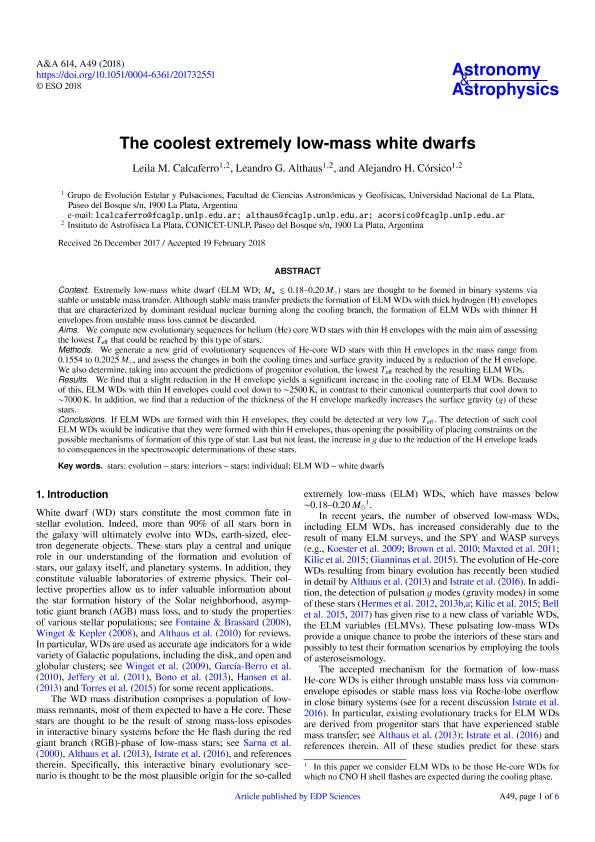Artículo
The coolest extremely low-mass white dwarfs
Fecha de publicación:
02/2018
Editorial:
EDP Sciences
Revista:
Astronomy and Astrophysics
ISSN:
0004-6361
Idioma:
Inglés
Tipo de recurso:
Artículo publicado
Clasificación temática:
Resumen
Context. Extremely low-mass white dwarf (ELM WD; M∗ ≲ 0.18-0.20 M⊙) stars are thought to be formed in binary systems via stable or unstable mass transfer. Although stable mass transfer predicts the formation of ELM WDs with thick hydrogen (H) envelopes that are characterized by dominant residual nuclear burning along the cooling branch, the formation of ELM WDs with thinner H envelopes from unstable mass loss cannot be discarded. Aims. We compute new evolutionary sequences for helium (He) core WD stars with thin H envelopes with the main aim of assessing the lowest Teff that could be reached by this type of stars. Methods. We generate a new grid of evolutionary sequences of He-core WD stars with thin H envelopes in the mass range from 0.1554 to 0.2025 M≲, and assess the changes in both the cooling times and surface gravity induced by a reduction of the H envelope. We also determine, taking into account the predictions of progenitor evolution, the lowest Teff reached by the resulting ELM WDs. Results. We find that a slight reduction in the H envelope yields a significant increase in the cooling rate of ELM WDs. Because of this, ELM WDs with thin H envelopes could cool down to 2500 K, in contrast to their canonical counterparts that cool down to 7000 K. In addition, we find that a reduction of the thickness of the H envelope markedly increases the surface gravity (g) of these stars. Conclusions. If ELM WDs are formed with thin H envelopes, they could be detected at very low Teff. The detection of such cool ELM WDs would be indicative that they were formed with thin H envelopes, thus opening the possibility of placing constraints on the possible mechanisms of formation of this type of star. Last but not least, the increase in g due to the reduction of the H envelope leads to consequences in the spectroscopic determinations of these stars.
Palabras clave:
Stars: Evolution
,
Stars: Individual: Elm Wd
,
Stars: Interiors
,
White Dwarfs
Archivos asociados
Licencia
Identificadores
Colecciones
Articulos(IALP)
Articulos de INST.DE ASTROFISICA LA PLATA
Articulos de INST.DE ASTROFISICA LA PLATA
Citación
Calcaferro, Leila Magdalena; Althaus, Leandro Gabriel; Corsico, Alejandro Hugo; The coolest extremely low-mass white dwarfs; EDP Sciences; Astronomy and Astrophysics; 614; 2-2018
Compartir
Altmétricas




